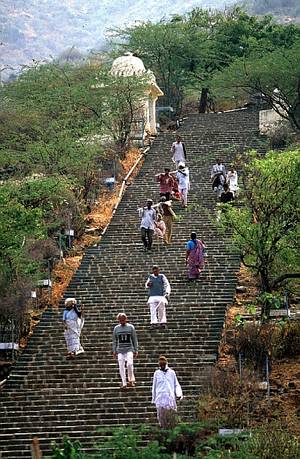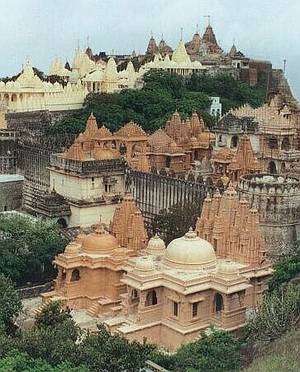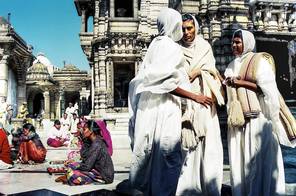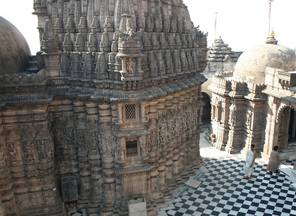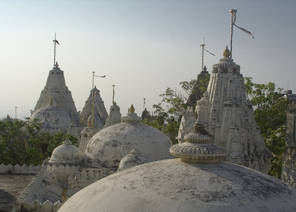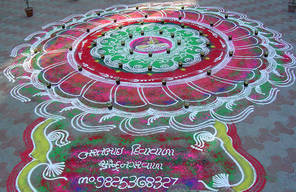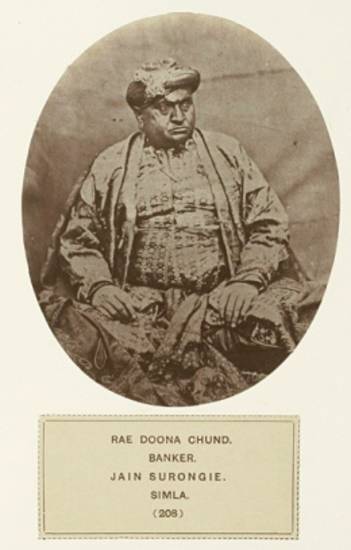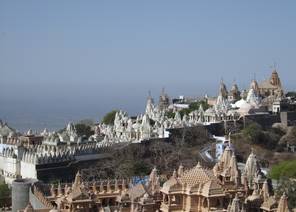Article: Mount Śatruñjaya
Shatrunjaya – Mount Śatruñjaya – is one of the paramount holy places for Jains, especially the Śvetāmbara Mūrti-pūjakas. A large hill with two summits outside Palitana in Gujarat, 40 kilometres from Bhavnagar, Shatrunjaya has a special connection with Ṛṣabhanātha or Lord Ṛṣabha. Also called Ādinātha or Adishvar, meaning ‘First Lord’, Ṛṣabha is the first Jina and is worshipped in the largest and most conspicuous temple on the site.
Though the site dates back to around the fifth century, it has undergone several major renovations, with the 19th century seeing the most intense period of building activity. In the course of time Shatrunjaya has become a ‘temple-city’, boasting almost a thousand shrines of varying size and importance. Not only the temples but virtually each and every spot on the hill at Shatrunjaya is considered holy, with magical and supernatural beliefs surrounding the whole place. Shatrunjaya is associated with several Jinas and plenty of legendary figures, both underlining and deepening the sacred nature of the site.
As probably the pre-eminent pilgrimage centre for Śvetāmbara Mūrti-pūjaka Jains, Shatrunjaya now attracts about 400,000 pilgrims every year, according to official figures. All festivals linked with Ṛṣabha are celebrated with especial fervour at Shatrunjaya. For example, the main Adishvar Temple is the most auspicious place in which to end the year-long varṣītap fast, which is marked by the Akṣaya-tṛtīyā festival.
Myths and stories connected with Shatrunjaya abound and it has been a favourite topic for musical, literary and visual works of art for centuries. As such a well-known place, it has aroused competing claims to ownership. Nowadays, the temples in Shatrunjaya and Palitana – which boasts numerous temples itself – are run by the Ānandji Kalyānji nī peḍhī.
One of the five Jain holy places
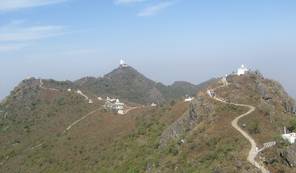
Peaks of Mount Sammeta
Image by CaptVijay © public domain
Shatrunjaya is one of the five holy places which make up Jain sacred geography, according to several medieval and modern or contemporary accounts (see, for example, Tod 1839: 276). The other holy places are:
Sacred nature of Shatrunjaya
Shatrunjaya has several names, which highlight its longstanding importance in Jain sacred history and legends. Its holiness has many sources. The main one is its connection with events in the life of the first Jina, known as Ādinātha or Ṛṣabhanātha – Lord Ṛṣabha – and figures around him. More broadly, Shatrunjaya is linked with several Jinas and legendary figures.
These associations are captured in physical form, which offer focal points for worship. The topography of the site is also considered holy, with natural features such as stones and lakes having become powerful parts of the sacred landscape. The holiness of these features stems chiefly from the presence of the Jinas.
Different names

View of Shatrunjaya temples
Image by Nirajdharamshi © CC BY-SA 3.0
Shatrunjaya is known by a number of names. Most of these names come from legend, unless it is the reverse – a legend coined to explain a name. This is a sign of the respect and value the location has in the eyes of followers as, for example, the Jinas or the Hindu gods may be called by 108 or 1008 names.
A traditional list contains 21 names for Shatrunjaya (Tod 1839: 277–278; Kanchansagar-suri 1982: 28 and so on) but there are variations in the number and also in some of the names. Only a few well-known examples are given here. The term Śatruñjaya means ‘conquering the enemies’ and some legends give the origin of this name in the story of a king. But, in the Jain context, the enemies are also within one’s own soul – in the form of passions, sins and so on – since detachment is the goal of living. This notion certainly also underlies the name of the hill.
Some names underline a specific feature of the site, such as:
- Siddhācala – ‘Mountain of Emancipation’
- Siddha-kṣetra – ‘Area of Emancipation’
- Muktinilaya – ‘Abode of Emancipation’.
Association with holiness
The hill of Shatrunjaya has been sacred for centuries. The holy nature of the site has three main foundations. Any place associated with one of the 24 Jinas is considered sacred and the same is true of places connected with significant people in Jain religious belief and legend.
These associations have been made concrete over the years in the form of shrines and relics honouring the Jinas and holy individuals. In addition, advanced spirituality is found in the physical landscape. This holiness bestows supernatural powers on parts of nature such as trees and ponds.
Jinas and holy people
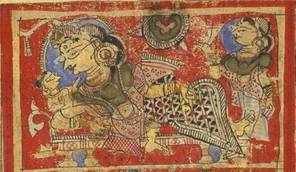
Marudevī and the baby Ṛṣabha
Image by Victoria and Albert Museum © V&A Images/Victoria and Albert Museum, London
According to the Jain tradition a number of mythical figures reached final emancipation on this hill. The main ones are:
- the first Jina, Ṛṣabhanatha or Lord Ṛṣabha
- his first disciple – gaṇadhara – Puṇḍarīka, accompanied by 50 million ascetics
- his eldest son Bharata
- the five Pāṇḍavas, according to the Jain version of the Mahābhārata epic poem.
Numerous mythical kings, princes and ascetics are also associated with Shatrunjaya. Their names and stories are told in writings connected with the place. One of these important figures is Marudevī, the mother of the first Jina. She seems to have been worshipped there since the 12th century if one relies on what the Jain monk Hemacandra writes. Four images of her are found today on the hill. More generally, many legendary figures who were contemporaries of the first Jina journeyed to Shatrunjaya. Many heroes spent some time on the hill in a period of spiritual progress. Several of them are contemporaries of Neminātha or Lord Nemi, the 22nd Jina, and his cousin Kṛṣṇa.
In addition, Shatrunjaya is said to have been visited by many Jinas, who preached there. Śāntinātha or Lord Śānti, the 16th Jina, is said to have spent eight rainy seasons meditating there.
Hence the place is an embodiment of sacredness, which deserves to be called ‘King among Holy Places’ – Tīrtha-rāja or Tīrthādhirāj – or ‘King of Mountains’ – Giri-rāj.
Both on the way to the top of the hill and on the two summits, there are physical reminders of all the main figures connected with the site. These individuals are represented as images housed in shrines of various sizes or in the form of footprints – pādukās. There are, for instance, several images of Ṛṣabha, his first disciple Puṇḍarīka and so on.
Sacred landscape
Mountains and high places are believed to have great spiritual qualities in Indian culture generally. Supernatural acts carried out there are enhanced and the high places also draw part of their magical powers from such miracles. The whole hill of Shatrunjaya has many supernatural qualities that pervade the landscape. The hill abounds in tens of:
- sacred trees
- fountains or reservoirs – the pure waters of which can cure illness
- stones that are supposed to be more or less magic.
Such features partly explain the association of Shatrunjaya with tales of the legendary wizard Nāgārjuna, who is said to have performed miracles and alchemy on the hill. Nāgārjuna was supposedly the pupil of a sage called Pādalipta, which, tradition states, is the origin of the name ‘Palitana’.
Palitana
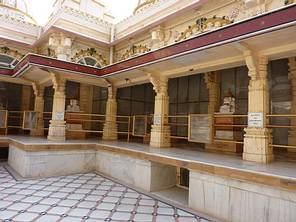
Engravings of the Śvetāmbara Mūrtipūjak scriptures
Image by Nalini Balbir © Nalini Balbir
As a major holy place for Jains, Shatrunjaya sees hundreds of thousands of pilgrims annually. To get to Shatrunjaya the visitor must first reach the small town of Palitana, which is on a vast plain. Since no one is permitted to stay overnight on Mount Shatrunjaya itself, pilgrims stay in the numerous rest-houses – dharma-śālās – built in the town over the last two centuries. The rest-houses line the main street, known as Taleti, but the lands behind have now started to become crowded with new buildings as well. They are usually equipped with dining halls for pilgrims – bhojana-śālās.
The number of these dedicated buildings amounts to a rather impressive infrastructure, without equal in other Jain holy places. Rest-houses of all levels of comfort are found. Some of them are luxurious and well appointed, hosting rich lay Jains settled all over India and abroad. Others are very basic places for pilgrims on a strict budget while many others cater for all levels of cost and comfort in between. The rest-houses are managed by regional communities of specific monastic orders. This is a significant factor when pilgrims select one rather than another.
Many temples are also found in Palitana and their number is always increasing. Two notable ones close to the bottom of the hill are:
- the temple known as Āgam Mandir – ‘Temple of Scriptures’
- the temple containing a model of the continent of Jambū-dvīpa.
The former was constructed in 1942 at the instigation of the Śvetāmbara monk Ānandasāgara-sūri. The 45 scriptures recognised as authoritative by the Śvetāmbara Mūrti-pujak Jains are engraved on its walls. The second temple explains Jain cosmology in a pedagogical manner and justifies it in a polemical manner with posters.
At the end of Taleti is the official path leading up the hill. On the left side is the Jay Taleti Temple. In front of this temple, underneath it, the base of the hill is visible as a large strip of dark grey stone. A focus of worship for pilgrims before they start climbing the hill, it is regarded as representing the sacred hill itself. It is also considered a surrogate for Mount Shatrunjaya for those who are not strong enough to get to the peak. The top of the stone is covered with gold or silver paper and flowers scattered by devotees.
Visiting Shatrunjaya
Palitana and the hundreds of temples on Shatrunjaya are managed by the Ānandji Kalyānji nī peḍhī, one of the most prominent Śvetāmbara Jain Mūrti-pūjak trusts involved in the preservation and development of holy places. The site is strictly regulated, with the principal rules being that:
- nobody is allowed to stay overnight on Mount Shatrunjaya
- pilgrimages cannot be made during the rainy season
- nothing made of leather or fur can be taken up the hill
- visitors should enquire about the regulations on photography.
In effect, this means that all visitors have to come down before sunset and Shatrunjaya is accessible only from October to June.
Jain sacred places are usually high up and Shatrunjaya is no exception. Visitors must reach the top on foot or be carried in a kind of palanquin called a ḍolī. Though the path to the top is often steep, many pilgrims go barefoot. On the way up, visitors pass many shrines and holy spots, along with resting places.
There are two main centres of pilgrimage on the hill, which are frequently crowded. The southern summit is the site of the principal temple, the Adishvar Temple dedicated to Ṛṣabhanātha or Lord Ṛṣabha, the first of the 24 Jinas. It is surrounded by smaller temples and shrines. The other chief pilgrimage destination is the ‘Nine Enclosures’. Many temples are found in these enclosures, which are scattered on the northern peak and the valley between the two summits. The other holy spots on the hill can be reached by following less-crowded paths.
Reaching the two summits
The top of the hill is 600 metres above sea level, rising high above the surrounding plain. There are two peaks, both of which can be reached only on foot or in kinds of palanquins – ḍolīs. These are seats on which a visitor sits cross-legged, and which is slung on bamboo poles carried by two men.
Pilgrims usually aim to visit the principal Adishvar Temple on the southern summit, where they worship the main idol. They will generally then walk round the major temples sited in the ‘Nine Enclosures’, found on the northern peak and the valley between the two summits.
After going through the official entrance, the visitor walks up a well-maintained but steep path made up of stone slabs and steps. There are four thousand steps. The average time needed to reach the top is two to three hours, but mendicants are often seen elegantly climbing or going down at a very quick pace and can take much less time. They walk barefoot and are sometimes imitated by ordinary people.
The path winds past many small shrines – dehris – altars, and sacred footprints – pādukās – which are dedicated to:
- Ṛṣabhanātha or Lord Ṛṣabha
- other Jinas
- Puṇḍarīka
- Bharata
- Indrabhūti Gautama
- the goddess Sarasvatī.
Devotees are thus immersed in a religious atmosphere from the start, preparing them for the all-pervading presence of the first Jina in the main temple. Before reaching the main image at the top of the hill, pilgrims see several idols of Ṛṣabha on the way, for instance in the Babu Temple, which is not far from the start.
As pilgrims begin climbing, they see on the right side a recent three-tired circular building. This is the Samavasaran Mandir, which was inaugurated in 1986 after 14 years of construction. It is a three-dimensional representation of the samavasaraṇa – the general preaching of a Jina. On the left, the Babu Temple is dedicated to Ṛṣabha, the first Jina, also called Ādinātha.
A small shrine is dedicated to Hinglaj Devi, the name given locally to the goddess Ambikā, the female attendant of the 22nd Jina, Neminātha or Lord Nemi. According to tradition, she fought a victorious battle against a local demon, Hingul, who used to frighten pilgrims. The beaten demon asked Ambikā to have enough mercy to keep his name.
The pilgrims can rest on the way at the seven stopping-places, stone shelters which provide shade. Fountains or reservoirs – kunds – provide water. The costs of building these have been borne by wealthy lay Jains over the centuries. The ‘Kumar Kund’ was erected to commemorate King Kumārapāla of Gujarat. Built in 1861, the ‘Iccha Kund’ takes its name from its patron, the merchant Icchachand, while the ‘Chala Kund’ also dates back to the 19th century.
As the pilgrims go higher, they gain an impressive view of the River Shetrunji, which flows across the mostly dry plains around the region into the Gulf of Cambay. In recent years, a dam has been constructed across the river. Plans to reforest the hill around Palitana began with small-scale tree planting in 1997, at the initiative of the Institute of Jainology.
Higher up the stairs, on the right side is the first modern enclosure – the ‘Shri Pujya Tunk’ – from where pilgrims get a nice view of the ‘Nine Enclosures’ at the top of the hill. Then they pass a small shrine housing four black statues of:
- Dravid and Varikhil – two grandsons of Ṛṣabha, who attained salvation in Shatrunjaya after realising that the massacres resulting from their fight were useless
- Aimutta – a prince who became a monk as a child, attained omniscience and preached the Śatruñjaya Laghu Kalpa, a text about Shatrunjaya
- Narada – a contemporary of Kṛṣṇa, who, though he is usually known for his quarrelsome nature in India, is known to the Jains for having reached omniscience and emancipation here.
Another shrine contains black idols of a group of five heroes, who are said to have reached final emancipation on this spot, namely:
- Ram
- Bharata
- Thavacchaputra
- Shukacharya
- Shelakacharya.
The shrine dedicated to Hanuman – ‘Hanuman Dehri’ – the monkey-god sits at a fork in the road. Pilgrims are advised to take the left-hand path, to the southern summit, which boasts the main Adishvar Temple. The right fork goes to the ‘Nav Tunk’ – the ‘Nine Enclosures’.
James Tod (1839: 281ff.) gives an almost step-by-step account of his ascent in November 1822, which nicely evokes how pilgrims progressively approach ‘the holy of holies’ – the temple of Ādinātha.
The hill and its temples
The nearly thousand temples that make up the temple-city of Shatrunjaya are distributed over the two summits of the hill, the northern and the southern, and in the valley in between. They are surrounded by a wall, like a fortress. It is impossible to list and describe here each of the temples or holy spots because there are too many. The main ones are organised in tunks, a Gujarati word that means ‘enclosure’ and which refers to the complex formed by a main temple and the subsidiary shrines enclosed within the same wall.
Tod’s account, which gives the names, locations and descriptions of the temples and tunks existing at the time of his visit, is practically the first one in Europe that is reliable and clear. Some decades later came the standard work, The Temples of Śatruñjaya, written by James Burgess, who was director-general of the Archaeological Survey of India. The 1879 book included black and white photographs, which are now all available in the British Library online gallery. Both these accounts provide a precise picture of the condition of the temples at the time of writing. Reprinted in India in 1976, Burgess’s work remains the standard publication, since its quality has not been surpassed by modern pamphlets or books. However, modern publications are, obviously, indispensable as they describe the present condition of the site, corresponding to what visitors can see today.
Southern summit
The highest point of Shatrunjaya is the southern summit, where the principal Adishvar Temple is. The main enclosure is here, known by a few names, such as:
- ‘Mūlanāth’ or ‘Dada ni Tunk’, with reference to the first Jina, Ṛṣabhanātha or Lord Ṛṣabha
- ‘Vimal Vasahi’
- ‘Marudeva Shikhar’.
In some descriptions of Shatrunjaya it is counted as the first of the ‘Nine Enclosures’ while in others it is treated separately. Here it is described separately, with details of the Nine Enclosures given under the heading Northern summit and valley.
The main enclosure has four gates through which pilgrims can pass. Inside, there are several shrines and smaller temples in addition to the main temple, which is the foremost site for Jain devotees. Pilgrims are advised to visit the temples in a certain order.
Gates and shrines
Against the inner walls of the main enclosure are smaller shrines and a reservoir. There are four gates to the enclosure, namely:
- Ram-pol – ‘Ram Gate’
- Sagal-pol
- Vaghan-pol – ‘Tigress Gate’
- Hathi-pol – ‘Elephant Gate’
The principal gate is the Ram-pol – the ‘Ram Gate’. Passing this gate, pilgrims see the ‘Five Shikhar Temple’, a temple dedicated to the 13th Jina, Vimalanātha or Lord Vimala. Following the wall, they come to the next gate, Sagal-pol, and after going up more steps, the Vaghan-pol or ‘Tigress Gate’.
Between the Vaghan-pol and the Hathi-pol – ‘Elephant Gate’ – the pilgrims come across:
- a temple to Śāntinātha or Lord Śānti
- a small shrine to Cakreśvarī – the yakṣī of the first Jina
- a temple to Neminātha or Lord Nemi
- the ‘Punya Pap ki bari’ – ‘Gateway of Virtue and Sin’ – which is a freestanding room housing a statue of a man mounted on a camel. With very little space to pass between the camel’s legs, it is said that only virtuous people succeed
- a temple built by King Kumārapāla
- Suraj Kund – a reservoir of reputedly magical waters, which, after they bathed in it, cured the legendary King Mahīpāla of leprosy and restored to human shape a king who had been transformed into a parrot
- Veer Vikramshi – a statue commemorating a legendary hero who died fighting a lioness that was frightening people.
The last gate is the Hathi-pol, which takes its name from the stone elephant on each side.
Main temple – Adishvar Temple
The courtyard where the temple is found is often called Ratan-pol – ‘Jewel Gate’. It has this name because, according to tradition, a pilgrim goes through the gate and first catches sight of the temple, which is like a jewel. Here is the principal Adishvara or Adishvar Temple of Shatrunjaya, one of the most important focal points of worship, located at the highest point of the summit.
The building houses a white marble image of the first Jina, Ṛṣabhanatha or Lord Ṛṣabha, sitting in the lotus position, with his emblem the bull carved beneath. There is a relief of a peacock and a snake, which is an emblematic motif of Shatrunjaya. In the vestibule there is an image of Ṛṣabha’s mother Marudevī seated on an elephant, holding in her arms her grandsons Bharata and Bāhubali. Behind the temple is the Surya Kund, a round water tank.
Other places in the main enclosure
All Jain temples are set on high platforms or terraces and when visiting a temple walking around its outside – pradakṣiṇā – is part of the ritual. Pilgrims to the Adishvar Temple are advised to make three circumambulations to discover adjacent temples or holy spots.
In the first circumambulation pilgrims see:
- the Sahasrakuta – a huge marble slab showing 1024 images of Jinas, including all of them everywhere in the Jain universe
- 1452 footprints of all the chief disciples – gaṇadharas – of each and every Jina
- a temple dedicated to Sīmandhar-svāmī
- an image of the goddess Ambikā.
Walking round the second time, the visitors can see:
- New Adishvar – a 14th-century temple built by the ministers Vastupāla and Tejaḥpāla
- the Sammet Shikhar temple.
The third circumambulation displays:
- the ‘Five Brothers’ temple, built in 1610 by five brothers from Ujjain, containing five Jina images
- the Neminath Temple, with a seated black image of the 22nd Jina
- a representation of the legendary mountain of Aṣṭāpada or Ashtapad, where Ṛṣabhanātha or Lord Ṛṣabha attained liberation
- the ‘Rayan tree’, under which, according to tradition, the first Jina preached his first sermon, leaving his footprints at the bottom
- a relief of a snake and a peacock, and another one showing a lion and an elephant
- a temple showing the first Jina in the kāyotsarga position flanked by his grandsons Nami and Vinami
- images of Ṛṣabha’s sons Bharata and Bāhubali
- the temple of 14 jewels.
In the main enclosure, pilgrims can also visit:
- the Nutan Jinalay – ‘New Jain Temple’ – consecrated in 1972, dedicated to the first Jina and built in red stone
- the oldest image of Puṇḍarīka, first disciple of the first Jina, dating back to the 11th century
- the small Gandhariya Chaumukh temple, housing four-faced images of the 16th Jina, Śāntinātha or Lord Śānti
- the Pundarik Swami Temple.
Northern summit and valley
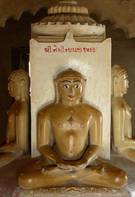
Four-faced statue of Neminātha
Image by liketearsintherain – tommy © CC BY-SA 2.0
In descriptions of Mount Shatrunjaya the temples and enclosures found outside the southern summit are commonly grouped into the ‘Nine Enclosures’ – ‘Nav Tunk’ in Gujarati. This is the model followed here.
In order to reach these Nine Enclosures pilgrims have to leave the southern summit, go back down to the fork in the road and then take the other branch of the road.
Walking along that fork to the gate leading to the enclosures, visitors pass the ‘Angar Shah Pir’. This shrine of a Muslim saint is of unclear origin.
The first seven enclosures are on the northern summit, the last two in the valley.
In the order of access from the road, they are as detailed in this table.
|
Enclosure |
Name |
Date |
Description |
|---|---|---|---|
|
1 |
Narshi Keshavji Tunk |
1862 to 1864 |
Of white marble, the main temple has two storeys and is dedicated to the fourth Jina, Abhinandananātha or Lord Abhinandana. It was the most recent construction when Burgess surveyed and described the site. |
|
2 |
Chaumukhji Tunk – also called Khartar Vasi and Sava Somji Tunk |
rebuilt in 1618 to 1619 |
The most imposing structure on this part of the hill, the main temple houses a colossal four-faced image of the first Jina. There is also a shrine dedicated to Puṇḍarīka, the first disciple of Ṛṣabha. |
|
3 |
Chipa Vasi Tunk |
built during the 14th century and renovated in 1735 |
Although the main temple is dedicated to Ṛṣabha, other Jinas are also associated with this spot. It is said that here Nandiṣeṇa composed the famous Ajita-Śānti-stavana, a hymn of praise dedicated to the second Jina, Ajitanātha or Lord Ajita, and the 16th, Śāntinātha or Lord Śānti. |
|
4 |
Shakar Shah Tunk |
1836 |
The main temple is dedicated to Chintamani Parshvanath. |
|
5 |
Ujambhai Tunk |
1848 |
Nandishvar-dvip Temple has 57 marble miniature temples, each with a four-faced Jina image. |
|
6 |
Sheth Hemabhai Tunk |
1826 |
Dedicated to the second Jina, Ajita, the main temple contains a major inscription. It gives the genealogy of a wealthy family from Ahmedabad and an account of its religious activity in Shatrunjaya and other holy places in Gujarat (Kanchansagar-suri 1982: number 160). |
|
7 |
Premchand Modi Tunk – also called Prema Vasahi |
1786 |
Found at the highest level, the main temple is dedicated to the first Jina and to Puṇḍarīka, his first disciple. |
|
8 |
Balabhai Tunk – also called Balavasi |
1836 to 1837 |
The main temple is the Chaumukh Temple, dedicated to the first Jina. |
|
9 |
Sheth Moti Shah Tunk |
1836 |
Built over a ditch between the two summits, the principal temple is dedicated to the first Jina. The ditch had first to be filled in, which required 1100 architects and 300 workers. |
Other routes and holy spots
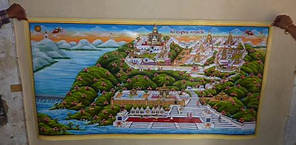
Contemporary map of Shatrunjaya
Image by Nalini Balbir © Nalini Balbir
The first aim of all pilgrims to Shatrunjaya is to reach the principal Adishvar Temple and worship its main image. Then they will take the tour of the Nine Enclosures. Besides these two main routes there are paths that are generally less frequented. These tend to be taken by pilgrims who have more time and want to do a full tour or by those who practise special fasts or rituals. These other routes lead to remote areas on the hill that are also sacred.
These quieter holy places include those described in the table.
|
Route |
Description |
|---|---|
|
Gheti pag |
A short route leading to a small hamlet at the northern foot of the mountain. One gets there by descending a little after the main Adishvar Temple. Footprints of the first Jina are enclosed in a small shrine said to have been built in 1156 CE. |
|
‘Dodh gau’ |
Covering about 3.5 kms, this route is ‘a circumambulation of the main temple complex on a path a little below the summit, connecting the main route with the Gheti pag route as a semi-circle’ (Luithle-Hardenberg 2010: 370). |
|
‘Tran gau’ |
This is a longer route than the direct path to the top of the southern summit, site of the Adishvar Temple. |
|
‘Cha gau’ |
A 12-mile tour covering a full circumambulation of the hill, going east from Ram-pol, this is the longest and most difficult route. It includes the following holy places:
|
Shatrunjaya timeline
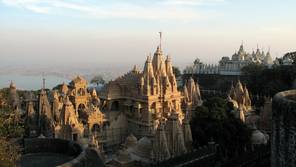
Mount Shatrunjaya temples
Image by Amre Ghiba © CC BY-NC 2.0
There is a sharp contrast between the antiquity of the legendary figures connected with Shatrunjaya and relatively recent historical inscriptions and monuments.
Today Mount Shatrunjaya is a real temple-city – all the general views of the place show a crowd of temple spires. But this is the result of progressive development, with a clear increase during the 18th and 19th centuries. Building activity is a sign of the liveliness of the site. In recent years, even though no temple has been added to the top of the hill, construction continues in the locality of Palitana.
The chronological stages of the site can be distinguished and are summarised in the table.
|
Date |
Activity |
|---|---|
|
6th century onwards |
|
|
1006 |
Image of Puṇḍarīka is installed and a preaching monk set up by a merchant in honour of his guru (Shah 1987: figure 177; Dundas 2002: 223) |
|
1075 |
Image depicting a prosperous lay man is unveiled (Dundas 2002: 223) |
|
13th and 14th centuries |
Completion of:
|
|
1593 |
Hīravijaya-sūri, the leader of the Tapā-gaccha monastic order, leads a massive pilgrimage and then the ‘probable consecration by him of the temple dedicated to Ṛṣabha by the merchant Tejpāl Sonī’ takes place (Dundas 2002: 223) |
|
1656 |
The Jain community, represented by businessman Śāntidāsa Jhaveri from Ahmedabad, is exempted from tax by the Muslim governor of Gujarat. The businessman is granted supervision of Palitana (Dundas 2002: 223) |
|
18th century onwards |
Ānandji Kalyānji nī peḍhī takes charge of Palitana and Shatrunjaya, beginning an active period of construction. |
|
19th century |
|
|
20th century |
|
Shatrunjaya in writing and song
Jain holy places draw homage, devotion and praise from believers. Traditionally, such places are not written about in neutral terms or merely described. Even the numerous booklets about individual sacred places published today do not just describe the physical place. Descriptions usually include all the legendary events or signs that create the meaning and sanctity of a holy place.
Since Shatrunjaya represents something eternal for Jain followers, it is natural to expect traces of it going back to high antiquity. The few mentions found in Śvetāmbara canonical scriptures of Sattuṃjaya – the Prakrit form of the name – underline the main characteristic of the site. This is the association with emancipation, which is gained by various heroes after they have performed the ritual of fasting unto death. The Pāṇḍava brothers are among them.
There are two principal types of writings in or about Shatrunjaya. At the site itself there are many inscriptions, many of them dating back centuries. These record significant events and perhaps the names of important individuals associated with these events. The other main type of writing is the blend of descriptions and legends called kalpas and māhātmyas. These often elaborate works combine a guide to the site with associated legends, and often contain material that is useful to historians of the place.
Jain hymns frequently refer to places believed to be sacred. These devotional songs are chanted during pilgrimages, whether to the place itself or as a mental pilgrimage. As a key pilgrimage site, Shatrunjaya is the subject of hundreds of hymns.
Interesting material about Shatrunjaya can be found in the large numbers of DVDs and books produced in modern times. These mix descriptions of what the visitor sees with historical detail and information a pilgrim would need, such as the right hymn to sing at a certain shrine.
Inscriptions
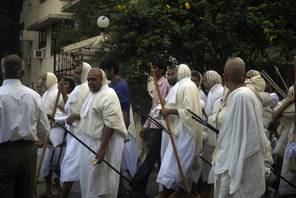
Śvetāmbara monks
Image by Hoorob – Robert Tyabji © CC BY-NC-ND 3.0
More than five hundred inscriptions are found on the pedestals of the images and the walls of temples and small shrines in Shatrunjaya. Some have been collected in Kanchansagar-suri, for instance. Two exceptional inscriptions from the 11th century have been mentioned above. The earliest ones otherwise were written in the 13th to 14th centuries. The majority, however, is much later, with key periods of activity being the 16th to 19th centuries. The language of the inscriptions is predominantly Sanskrit, though Gujarati is sometimes found.
The inscriptions record the following acts or purposes:
- construction or renovation of a temple
- installation by an ascetic of an image that has been commissioned by a lay follower
- long inscriptions may include a full genealogy of lay families or monastic orders.
In Shatrunjaya the inscriptions that name monastic orders include all the main Śvetāmbara Mūrti-pūjak orders, the Tapā-gaccha, Kharatara-gaccha and Añcala-gaccha in particular.
In keeping with the long Śvetāmbara Mūrti-pūjak dominance of the site, Digambara inscriptions are rather isolated. A 17th-century one records the dedication of an image of the 16th Jina, Śāntinātha or Lord Śānti, by an inhabitant of Ahmedabad, a follower of the Digambara monastic leader Padmanandin (Guérinot: number 702).
Inscriptions from the Mughal period give clues to the relationship between the political power and the Jain community. It is also interesting to note that one Gujarati inscription from 1810 forbids the construction of any new temple in the Hathi-pol, the courtyard of the main Adishvar Temple, without the agreement of the entire community.
Kalpas and māhātmyas – oral transmission
Kalpas and māhātmyas are a skilful cross of descriptions and legends, resulting in a ‘site biography’ in an elaborate style. To some extent, they can be said to put into writing material that had traditionally been orally transmitted. At the same time, their content was probably more often passed on by the preaching of monks and temple priests than through direct reading by a large number of people.
Jinaprabha-sūri’s ‘Vividha-tīrtha-kalpa’
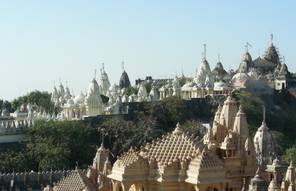
Temple-city of Mount Shatrunjaya
Image by liketearsintherain – tommy © CC BY-SA 2.0
The piece on Shatrunjaya opens this collection of texts on Jain holy places written in the 14th century by Jinaprabha-sūri, a Jain monk belonging to the Kharatara-gaccha. Enthusiastically praising the hill and the heroes associated with it, it is also a report on the building or renovation activities some of them undertook, whether they are real or legendary. It is not a guide in the strict sense of the word, but to some extent it follows a pilgrim’s progress, describing the shrines and images he will see on the way.
There is a cave to the north of the image of Ṛṣabha established by the Pāṇḍavas, and even today there is a small pond there; images are seen there due to the instructions of the yakṣa and [the Jinas] Ajita and Śānti also stayed there for a rainy season. To the east are their two temples, and near the Ajita temple is the [water] tank Anupamā.
translation by J. E. Cort in Granoff, 1990, page 250
Although this account cannot be used to draw a map of the temples, it shows some concern for topography, distinctions between past and present states and for all the spots contributing to the holy atmosphere. It draws on Jain mythology but, interestingly, also on recent history. It refers at one point to images broken by those Jinaprabha-sūri calls ‘barbarians’ – the Islamic power dominant in Gujarat at this time:
One cannot omit to praise the religious buildings undertaken by Vastupāla, and made by Pīthaḍa and others. The wise minister Vastupāla, elder brother of Tejaḥpāla, foresaw the destruction by the barbarian minister, and so after arranging for the making of extremely immaculate images with Mammāṇa gems, established images of the first Arhat [= Ṛṣabha] and Puṇḍarīka in the main building. In 1369 of the Vikrama era [= 1312 CE] the image established by Jāvaḍi was thrown down by the barbarians, due to the strength of Kali. In 1371 of the Vikrama era [= 1314 CE], the good blessed Samara restored the main image
translation by J. E. Cort in Granoff, 1990, page 250
Finally, one of the author’s main concerns is to emphasise the immense karmic merits one can gain in Shatrunjaya thanks to its extreme holiness. Overall, he is keen to stress the superior value of any religious activity undertaken there, whether it is meditation or donation.
The Śatruñjaya-māhātmyas
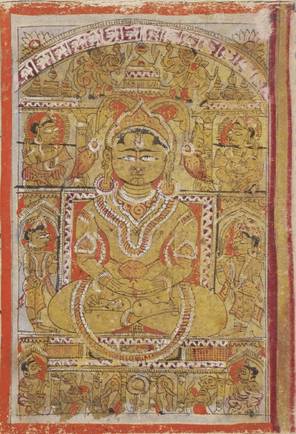
Worship of Ṛṣabha
Image by Victoria and Albert Museum © V&A Images/Victoria and Albert Museum, London
Celebrations of the Greatness of Śatruñjaya is the generic name of several works written mainly in Sanskrit. The most famous of them is Dhaneśvara-sūri’s version, probably written in the 14th century (see Weber) and which has remained the main source for stories relating to the holy hill. Visiting the place in the 1820s, the Briton James Tod reports that the Jains who were his guides had a portion of Dhaneśvara’s work with them. Modern compilations published in India about the history and legends of Shatrunjaya draw extensively on this text as well.
The Śatruñjaya-māhātmya is not a straightforward work, but rather a network of hagiographies and stories featuring the Jinas and other mythological figures. They stress, at least to some extent, their connections with Shatrunjaya and expand the tradition of this holy place. The texts have two chief purposes. One is to indicate that Shatrunjaya is extremely ancient, having been frequented by the first Jina Ṛṣabhanātha or Lord Ṛṣabha and his son Bharata, for instance. The other is to show that it has a history and a development. This aim underlies the significance of the chapter of the ‘16 Renovations’ of Shatrunjaya, a topic which has since become commonplace.
The author’s statue is housed in a small shrine in the principal enclosure, to the right of the entrance to the main Adishvar Temple.
Hymns of praise
There is a strong tradition of devotional songs about holy places, which extol either a place itself or the particular Jina image associated with it. These hymns are chanted on pilgrimages to these places or when models and paintings of the places are seen on daily visits to the temple. Given its importance, Shatrunjaya has inspired an infinite number of hymns in vernacular languages, especially Gujarati.
Among the notable examples of this genre is one in Prakrit, which is included in the category of Śvetāmbara scriptures known as Prakīrṇakas – ‘Miscellany’. This is the Sārāvalī in praise of Puṇḍarīka-giri, alias Shatrunjaya, a song that seems to date to a time when the site ‘was beginning to gain major prominence as a holy spot’ (Dundas 2002: 222). It features Nārada, a sage who reached emancipation on the hill. Like the other hymns, the Sārāvalī emphasises the site’s holiness by referring to the mythological figures who have given it sanctity, mainly by reaching final emancipation, and praises the merits gained from worshipping there.
Modern books and media
Books or DVDs produced today by the Jains are another source of knowledge about Shatrunjaya. In Gujarati, Hindi or English, they combine visual and textual material especially for pilgrims. Mixing features of a guidebook with religious practice, they are often called bhāva-yātrās – mental pilgrimages – to Shatrunjaya.
Thus they follow the pilgrim’s ascent to the top of the hill and his tour of the temples. They contain:
- detailed descriptions of each and every spot, footprint, shrine and temple
- summaries of traditional stories
- indications of religious formulas or mantras to be recited at various places in the process of caitya-vandana – ‘salutation to the temples’
- hymns of praise to the first Jina or to other figures, to be sung at their respective temples.
Shatrunjaya in visual art
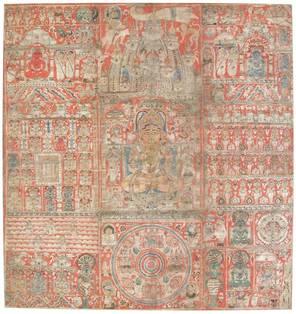
Worlds of gods and saviours
Image by San Diego Museum of Art © CC BY-NC-ND 2.0; Edwin Binney 3rd Collection
As a famous Jain holy place, the sight of which is said to secure karmic merits, Shatrunjaya draws large numbers of pilgrims. But it can also be represented in any temple outside the site or even in private houses. These representations take the form of:
- bas-reliefs or sculptures on temple walls
- metal plaques or panels
- cloth-hangings on temple walls or in houses – paṭas
- mural paintings from all periods, including the contemporary period.
One important instance of relief carving is in a temple at Ranakpur in Rajasthan, showing a combination of the temple-cities of Shatrunjaya and Girnar. It has stylised carvings of temples, standing Jinas, chariots and ponds. The peaceful atmosphere is symbolised by a snake and a peacock, which are normally natural enemies (Jain and Fischer 1978: plate XXXIb).
Depicting pilgrimage destinations in any medium is a way of guaranteeing the presence of these holy sites at all times and for all followers. These artworks are also surrogates for the physical journey of pilgrimage. In addition, they feature during rituals or religious commemorations connected with the holy place that is depicted. For example, the 17th-century Shatrunjaya paṭa preserved in the Ānandjī Kalyāṇjī nī Peḍhī in Ahmedabad is used for worship during the festival of Paryuṣaṇ (Hawon Ku 2007: 145). During their sermons, mendicants point out the sacred spots and their related legends to the listeners gathered in the temple.
The most significant type of artwork associated with Shatrunjaya is the paṭa. A large wall-hanging made of cloth, a paṭa is a very detailed map, though not one that is intended to help someone reach a certain place. Paṭas frequently depict images of the universe, a crucial concept in Jain cosmology or major temples and pilgrimage sites. Shatrunjaya is a favourite subject for this western Indian art form. Popular since at least the 17th century, paṭas of this site are so popular that a form called the Śatruñjaya paṭa has developed.
An unusual paṭa is preserved in Ladnun, Rajasthan (Sheth and Balbir 2010). It does not represent Shatrunjaya but each of the 24 Jinas. Divided into 24 sections, the accompanying text narrates stories of heroes in the time of each of the Jinas who reached final emancipation on Mount Shatrunjaya.
Śatruñjaya paṭas
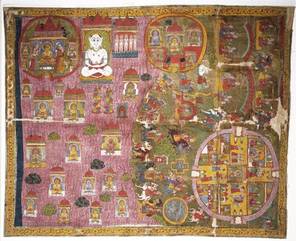
Paṭa of Mount Shatrunjaya
Image by Brooklyn Museum Collection © no known copyright
Early paṭas often represent holy places, especially Girnar and Shatrunjaya, by showing their main temple, for example the Adishvar temple for Shatrunjaya. However, murals and cloth-hangings depicting Shatrunjaya only have become a specific form of art often called Śatruñjaya paṭas. These can be compared with similar paintings for the Hindu sites of Nathdwara in Rajasthan and Puri in Orissa. Stylistically, they have developed over the centuries, with their own iconography that takes account of the changes at the site.
One of the oldest Shatrunjaya paṭas dates back to the 17th century. Made chiefly in Gujarat or Rajasthan, the art form developed extensively in the 18th and 19th centuries and remains popular among contemporary Jains. Local artists in Palitana produce Shatrunjaya paṭas when commissioned by rich lay Jains for their houses or by temple organisations. Their size ranges from around 1 metre in height and width to 3 metres in height. Their format is either that of a tall vertical composition or a horizontal one where the temples are spread out (figures 30 and 31 in Granoff 2009: 278–281).
The paintings may be accompanied by unique captions or inscriptions at the bottom, some of them bearing a date. In the vast majority of cases, iconography is the only means to identify temples and holy spots. Shatrunjaya paṭas can be recognised from three features (Hawon Ku 2007: 136ff.), namely:
- hills and wildlife indicating a remote place with a special atmosphere, though vegetation and animals can be shown in a rather more realistic manner
- a peacock and a snake, which are emblematic animals in the legends associated with Shatrunjaya and represented on the main Adishvar Temple. A pair of traditional enemies, they symbolise the general reconciliation of all beings when they listen to Jinas preaching in the samavasaraṇa
- depiction of the five Pāṇḍava brothers, who are believed to have reached final emancipation on the hill.
Other striking elements that are commonly found are:
- the main Adishvar Temple, generally represented as much larger than its real size and shown on the top of the painting, along with the image of the first Jina
- the locality of Palitana in the lowest part of the painting
- a yellow path showing the pilgrims’ routes
- gates showing the entrance to temple complexes
- various four-faced images of Jinas – caturmukha or caumukha figures.
The idea behind these motifs is to emphasise that the whole of Mount Shatrunjaya is a holy site, which gains its sanctity from its landscape and temples.
Comparing the older paintings with the new ones, it is clear how the style has changed to meet contemporary Indian tastes. But these paintings can also be used as historical documents to see how new elements have been added to Shatrunjaya over time. The visions are not frozen, repetitive representations of a mythical Shatrunjaya, but often incorporate images of recent constructions. These new elements create a more realistic picture and fulfil the believer’s desire to see the place as it is, not as an abstraction. Contemporary paṭas are cumulative and crowded, with no empty spaces – they depict older temples and newer ones side by side. By including new temples, the paintings mirror the involvement of the Jain lay community, who act as patrons of the site and contribute to its ever-increasing growth.
Although lacking orientation and scale, the paṭas can be extremely detailed and accurate topographical maps, showing the various routes and all the holy spots of the site. They often include the locality of Palitana. Thus the viewer sees both the sacred hill and its context, exactly as the pilgrim will first reach Palitana and then climb the hill.
When the paintings are more detailed, they depict Jina images in temples that are often close in architectural style to the real thing. Earlier paintings tend to show them in a stereotyped way.
The painters of the paṭas, whether small or huge, also intend to convey that Shatrunjaya is not just a place with monuments – it is a place of worship performed by living beings. Most of the paintings give the impression of liveliness and bustling religious activity, showing crowds of pilgrims climbing the hill, worshipping at temples and holy spots, and filling temple courtyards. Jain lay followers and mendicants are shown, but foreign visitors are also recognisable from their clothing and faces. As they visit the place in ever increasing numbers, they make up a rising proportion of Shatrunjaya visitors. Depending on the time when a paṭa was created, the dress codes vary.
Celebrations at Shatrunjaya
Shatrunjaya is a busy place when it is open to pilgrims, especially because it is believed that greater merit is gained from rituals performed there than elsewhere. Festivals act as magnets for even larger crowds. Even during the rainy season, when the hill is closed to religious visitors, plenty of mendicants and lay people draw inspiration from being near the holy site.
During the pilgrimage season, parties of travellers are constantly seen going up and down the hill. Inscriptions and manuscript colophons show that the organisation of pilgrimages to Shatrunjaya was always a favourite activity of wealthy businessmen, who gained the title of saṅgha-patis. More generally, patronage for the development of Shatrunjaya has grown up. This was especially noticeable during the 18th and 19th centuries, which saw several prominent men personally involved in the renovation or construction of buildings.
In addition to the pilgrimage season, there are special occasions in the year which coincide with Jain festivals. At these times Shatrunjaya attracts large crowds, led by community leaders.
All dates connected with the life of the first Jina, Ṛṣabhanātha or Lord Ṛṣabha, that are potential celebrations are marked with great pomp in Shatrunjaya, which is the main site associated with him.
|
Date in traditional calendar |
Event in the life of Ṛṣabha |
|
|---|---|---|
|
Vaiśākha Bright 3 |
||
|
Phālguna Bright 8 |
stays in Palitana for 99 pūrvas |
|
|
Phālguna Dark 8 |
birth and later initiation into monkhood |
|
|
Māgha Dark 13 |
||
|
Jyeṣṭha Dark 6 |
consecration of Ādinātha’s image in the main Adishvar Temple in 1530 |
Significant events in the lives of other figures associated with Shatrunjaya are also commemorated on certain dates.
|
Date |
Detail |
|---|---|
|
Phālguna Bright 10 |
Nami and Vinami, two kings who were contemporaries of the first Jina, reached final emancipation |
|
Phālguna / Phagan Bright 13 – February / March |
Kṛṣṇa’s sons, Shamba and Pradyumna, reached emancipation in Shatrunjaya. This is commemorated by the footprints carved in the small shrine on Mount Bhadava, a small hill on Shatrunjaya. |
|
Phālguna full moon |
Puṇḍarīka, the first pupil of the first Jina, started fasting unto death |
|
Caitra Dark 8 |
Puṇḍarīka reached final emancipation |
|
Caitra Bright full moon |
Nami’s 64 daughters reached final emancipation |
|
Kārtika Pūrṇimā – October / November |
Emancipation of Dravid and Vakhil, two of Ṛṣabha’s grandsons. |
|
Māgha full moon |
Anniversary of the Marudevī temple |
|
Jñāna-pañcamī – ‘Knowledge Fifth’ |
Tod (1839: 295) reports that the ‘literary riches’ preserved in the temple-library of the main Adishvar temple are brought out to groups of pilgrims |
Shatrunjaya is the first choice for any Śvetāmbara Mūrti-pūjak Jain wishing to perform ritual or special observances, as it is said that they bring many more merits than when performed anywhere else. The navanū – ‘99fold’ – pilgrimage is one of the hardest and most demanding ones. It requires a total of 108 pilgrimages to the Adishvar Temple, in this context each pilgrimage being a journey from the foot of the hill. It includes additional mandatory visits to the main temple and other ones, and a set of moral and dietary restrictions in daily life (see Luithle-Hardenberg 2010).
During the rainy season, climbing up the hill is not permitted. But numerous monks and nuns spend the four months of the rainy season in or near Palitana, wishing to be close to Shatrunjaya. A lot of Jain devotees do the same and can benefit from the mendicant presence during this period.
Ownership of the site

Pilgrim prays at Mount Shatrunjaya
Image by Marina & Enrique © CC BY-NC-SA 2.0
Despite the existence of a unique Digambara temple to the west of the main Adishvar Temple, the predominance of Śvetāmbara Mūrti-pūjaks in Shatrunjaya is not disputed. It has long been accepted that the place is strongly associated with this sect. The Digambara temple has no life of its own.
As spiritual leaders, monks and nuns have always had a strong presence at the site. This is indicated by the statues, footprints, shrines and inscriptions honouring prominent mendicants. In addition, the lay part of the fourfold community has been involved in Shatrunjaya for a long time. The extremely high standing of Shatrunjaya among Jains has long attracted donations from affluent patrons, some of whom are commemorated in art or in the name of a feature.
Down the ages the rich income from so many pilgrims and the interest of wealthy lay families has contributed to struggles over ownership of the site. Periods when Jains managed the site alternated with times when local rulers asserted ownership. This led to a spate of well-known legal cases in the 19th century, although the site has been managed solely by the Ānandjī Kalyāṇjī nī Peḍhī since the 1920s.
Mendicants
The presence of the Śvetāmbara Mūrti-pūjak monastic orders at the site of Shatrunjaya is conspicuous from two angles, namely the:
- inscriptions with details of names, monastic affiliation and spiritual genealogies
- images or footprints of prominent mendicants.
The inscriptions feature very frequent mentions of Kharatara-gaccha and Tapā-gaccha members whereas Añcala-gaccha mendicants are specified far less.
The images and footprints of leading monks and nuns are particularly associated with the Tapā-gaccha order.
|
Mendicant artefact |
Information |
|---|---|
|
statue of Hīravijaya-sūri |
A 16th-century Tapā-gaccha leader who was instrumental in granting free disposal of the site to the Jain community. After he led a large-scale pilgrimage to Shatrunjaya in 1593 to 1594, the place underwent a revival in the following decades. |
|
footprints of Hīravijaya-sūri |
In 1595 Vijayasena-sūri consecrated the footprints of his predecessor, who had died the same year, according to an inscription. |
|
small shrine to Vijayānanda-sūri |
A seated statue of a 19th-century teacher who had first been initiated into the Sthānaka-vāsin monastic order under the name Ātmarāmjī. He is said to have realised that worshipping a Jina image is worshipping the Jina, which caused him to leave the Sthānaka-vāsins and become a Tapā-gaccha monk. This can be viewed as a way of justifying the abundance of images and temples at the site. |
Lay patrons
The identity and social position of many lay followers who acted as patrons for temples or images are similarly visible. Favourite methods of commemorating their activities are naming buildings or infrastructure after them, inscribing details and creating statues.
Many of the enclosures, which were built in the 19th century, were named after the lay Jains who paid for their construction. Examples include:
- Moti Tunk after Sheth Motichand Amichand
- Balabhai Tunk after Balabhai, an accountant who worked for Motichand.
Several water tanks are named after their patrons, who are named in the inscriptions as rich merchants or businessmen from Ahmedabad, Bombay and other major trading centres, who were engaged in the growing trade of textiles, spices and perhaps also opium.
Several statues can be identified as portraits or stereotyped representations of donors or lay patrons, mainly from inscriptions. The dates of these artefacts point to the involvement of lay patrons throughout the development of Shatrunjaya as a holy site.
|
Date |
Information |
|
|---|---|---|
|
1006 CE |
Ammeyaka |
The figure on the lower panel at the base of a Puṇḍarīka image is probably of the donor of the image (Shah 1987: figure 177; Laughlin: 76) |
|
1075 CE |
Śreṣṭhī Nārāyaṇa |
A statue that probably represents the businessman was donated by his sons (Laughlin: 77). |
|
14th century |
Desala |
A businessman commissioned five portraits, of which three can be clearly identified as:
|
|
19th century |
|
In this period, portraits of influential lay men involved in the renovation and expansion of the site became more common (Laughlin: 78). |
In the 19th century in particular, individual patronage exercised by donors who were keen on displaying their wealth was commonplace. Wealthy donors formed a network based on family bonds and commercial activity (see Hawon Ku 2011).
Even in the 1820s, Tod (1839: 293–294) reports that Shatrunjaya was a rich endowment ‘managed by a committee of wealthy lay-votaries from the chief cities, [such] as Ahmedabad, Baroda, Patan, Surat etc.’ who were in charge of receiving the offerings and managing the treasury.
Later, around 1880, there was a shift as the management and distribution passed entirely to the hands of the Ānandjī Kalyāṇjī nī Peḍhī. This organisation became the sole authorised patron of the site, with exclusive authority to decide on proposed new constructions.
Legal disputes
- who should get the revenues from the site
- ownership of the hill and its immediate surroundings.
British authorities started detailed investigations into the history of ownership at the request of the Jains and the local ruler, and proclaimed that the Jains' right to the site were based on the 'religious purpose' of Shatrunjaya Hawon Ku 2007: 203In 1928, it was finally ruled that the Jains would manage the site, through the Ānandjī Kalyāṇjī nī Peḍhī, but that they would have to pay a fixed annual sum for 35 years. After the 35-year period the Ānandjī Kalyāṇjī nī Peḍhī took undisputed control.
Reading
- The Temples of Śatruñjaya: the Celebrated Jaina Place of Pilgrimage, near Pālitāṇā in Kathiawad
James Burgess - Gujarat State Committee for the celebration of 2500th Anniversary of Bhagwan Mahavira Nirvan; Gandhinagar, Gujarat, India; 1976
- Tirthadhiraja Shri Shatrunjaya: Tunk paricaya
M. A. Dhaky - Anandji Kalyanji Pedhi; Ahmedabad, Gujarat, India; 1975
- The Jains
Paul Dundas - Library of Religious Beliefs and Practices series; series editor John Hinnels and Ninian Smart; volume 14
Routledge Curzon Press; London, UK; 2002
- ‘Medieval Jain Accounts of Mt. Girnar and Satrunjaya: Visible and Invisible Sacred Realms’
Phyllis Granoff - Journal of the Oriental Institute
volume XLIX: 1–2
Baroda, Gujarat, India; 1999
- Victorious Ones: Jain Images of Perfection
Phyllis Granoff - Mapin Publishing Pvt. Ltd and Rubin Museum of Art, New York; Ahmedabad, Gujarat, India and New York, USA; 2009
- Répertoire d’épigraphie jaina
Armand Albert Guérinot - Imprimerie Nationale; Paris, France; 1908
- Jaina Temple Architecture in India: The Development of a Distinct Language in Space and Ritual
Julia A. B. Hegewald - Monographien zur Indischen Archäologie, Kunst und Philologie series; volume 19
Stiftung Ernst Waldschmidt, G+H Verlag; Berlin, Germany; 2009
- Śatruñjayakalpa
Jinaprabhasūri - edited by Muni Jinavijaya
Singhi Jain series; volume 10
Adhisṭhātā; Shantiniketan, West Bengal, India; 1934
- Shri Shatrunjay Giriraj Darshan in Sculptures and Architecture
Aagamoddharakshishu Acharya Kanchansagarsuri - Shree Aagamoddharak Granthmala series; volume 59
Aagamoddharak Granthmala; Kapadwanj, Gujarat, India; 1982
- Re-Formation of Identity: The 19th-century Jain Pilgrimage Site of Shatrunjaya, Gujarat
Kim Hawon Ku - PhD dissertation submitted to University of Minnesota in March 2007
- ‘Temples and Patrons: The Nineteenth-Century Temple of Motiśāh at Śatruñjaya’
Kim Hawon Ku - International Journal of Jaina Studies (Online)
edited by Peter Flügel
volume 7: 2
Centre of Jaina Studies, SOAS; 2011
- ‘Representations of Ownership: The Nineteenth-Century Painted Maps of Shatrunjaya, Gujarat’
Kim Hawon Ku - South Asia: Journal of South Asian Studies
volume 37: 1
2014
- ‘The “99fold“ pilgrimage to Shatrunjaya: A case study of young women’s embodiment of Jaina tradition’
Andrea Luithle-Hardenberg - Svasti – essays in honour of Prof. Hampa Nagarajaiah
edited by Nalini Balbir
Muddushree Granthamala series; volume 75
K. S. Muddappa Smaraka Trust; Bangalore, Karnataka, India; 2010
- ‘The Pilgrimage to Shatrunjaya: Refining Shvetambara Identity’
Andrea Luithle-Hardenberg - An Anthropology of Values – essays in honour of Georg Pfeffer
edited by Peter Berger, Roland Hardenberg, Ellen Kattner and Michael Prager
Pearson Longman; Delhi, India; 2010
- World Renowned Jain Pilgrimages: Reverence and Art
Mahopadhyaya L. Sagar - Prakrit Bharati Academy; Jaipur, Rajasthan, India; 2000
- Paṭadarśana (Tīrthaṃkara praṇīta dharmadeśanā antargata Śatruṃjaya māhātmya): The glory of Shatrunjaya as depicted in a 19th Century Jain scroll
Kalpana K. Sheth and Nalini Balbir - Jain Vishva Bharati University; Ladnun, Rajasthan, India;
- Travels in Western India: embracing a visit to the sacred mounts of the Jains and the most celebrated shrines of Hindu faith between Rajpootana and the Indus, with an account of the ancient city of Nehrwalla
James Tod - Munshiram Manoharlal; New Delhi, India; 1997
Links
- Views of Shatrunjaya temples
-
Collection of photographs of the temple-city of Mount Shatrunjaya. The pre-eminent Śvetāmbara pilgrimage site, Shatrunjaya has nearly a thousand temples. The main temple is dedicated to Ṛṣabha, the first Jina, often called Ādinātha or First Lord. These photographs are presented by Professor Frances W. Pritchett of Columbia University in New York.
- James Tod biography
-
An officer in the British East India Company, James Tod (1782–1835) published extensive accounts of the history and geography of India, including details of his travels in Gujarat and Rajasthan between 1819 and 1823. This entry from volume 56 of the Dictionary of National Biography (1885–1900) appears in Wikisource.
- Henry Cousens – photographing India
-
The Digital South Asia Library at the University of Chicago provides detailed information about some of the trips made from 1889 to 1895 by Henry Cousens (1854–1933) in British India. Accompanied by other members of the Archaeological Survey Department and Indian assistants, Cousens took photographs for survey purposes.
- Archaeological Survey of India – history
-
The Archaeological Survey of India was set up in 1784 by Sir William Jones in Calcutta. It began publishing the Asiatick Researches journal in 1788, which publicised the results of surveys of historical sites and monuments in India.
- Adinath procession at Shatrunjaya – part 1
-
This short YouTube video from 2011 captures part of a procession in the temple-city of Mount Shatrunjaya, in Gujarat. Chanting ‘Adinath’, the devotees are probably on their way to the main Adishvar temple, which is dedicated to Ṛṣabha. The first Jina, he is also known as Ādinātha or First Lord.
This is the first of four brief videos of the procession. You can watch the next part.
- Adinath procession at Shatrunjaya – part 2
-
This short YouTube video from 2011 captures a procession in the temple-city of Mount Shatrunjaya, in Gujarat. Chanting ‘Adinath’, the devotees are probably on their way to the main Adishvar temple, which is dedicated to Ṛṣabha. The first Jina, he is also known as Ādinātha or First Lord.
This is the second of four brief videos of the procession. You can watch the next part.
- Adinath procession at Shatrunjaya – part 3
-
This short YouTube video from 2011 captures part of a procession in the temple-city of Mount Shatrunjaya, in Gujarat. Chanting ‘Adinath’, the devotees are probably on their way to the main Adishvar temple, which is dedicated to Ṛṣabha. The first Jina, he is also known as Ādinātha or First Lord.
This is the third of four brief videos of the procession. You can watch the final part.
- Adinath procession at Shatrunjaya – part 4
-
This short YouTube video from 2011 captures part of a procession in the temple-city of Mount Shatrunjaya, in Gujarat. Chanting ‘Adinath’, the devotees are probably on their way to the main Adishvar temple, which is dedicated to Ṛṣabha. The first Jina, he is also known as Ādinātha or First Lord.
This is the last of four brief videos of the procession. You can watch the first part.
- Seven Wonders of India – Palitana Temples
-
The Svetāmbara pilgrimage centre at Mount Shatrunjaya is showcased in this NDTV video on YouTube. Jain pilgrims are shown climbing the steep hill – some carried in a kind of palanquin called a ḍolī – and worshipping in some of the hundreds of temples on the twin hills. The presenter gives a brief outline of the Jain faith and mentions the navanū – ‘99fold’ – pilgrimage, which is one of the hardest and most demanding ones.
Beginning in 2008, the New Delhi Television show Seven Wonders of India asked viewers to vote for their favourite seven sites in the country over a year. Part of a publicity campaign organised by the Ministry of Tourism, the show's presenters visited many sites considered potential winners.
- Kattiawar from the road up to Pallitana, Western India
-
This painting, called Kattiawar from the road up to Pallitana, Western India, is one of the views produced by English artist Marianne North, who travelled in India in 1877 to 1878. It forms part of the Marianne North Online Gallery at the Royal Botanical Gardens, Kew in the United Kingdom.
- A Śvetāmbara nun descends from Shatrunjaya
-
A nun from a Śvetāmbara Mūrtipūjaka mendicant order runs barefoot down the steps leading down from Mount Shatrunjaya. This temple-city in Gujarat is one of the most significant Śvetāmbara Mūrtipūjaka pilgrimage sites. The steep path from the foot to the summit, where the principal shrines are found, has around 4000 steps.
- Samavasaran Temple
-
A recent building, the Samavasaran Temple is in the town of Palitana at the foot of Mount Shatrunjaya, one of the most important pilgrimage sites for Śvetāmbara Mūrti-pūjaka Jains. Built as a stepped circle, the temple recreates the samavasaraṇa or universal gathering. When a Jina reaches omniscience, he sits in the centre of a samavasaraṇa the gods have built for him so all living beings can hear him preach.
The HereNow4U website has images of the temple.
- Paṭa of Mount Shatrunjaya
-
A 19th-century Rajasthani example of a paṭa – decorative map of a holy site – of the pilgrimage centre of Mount Shatrunjaya. Owned by the Philadelphia Museum of Art in the United States, the paṭa can be enlarged by clicking on the icon of the magnifying glass. A paṭa can be used to complete a mental pilgrimage to the place depicted, which is believed to be of even more religious value than making the physical journey.
http://www.philamuseum.org/collections/permanent/68189.html?mulR=31553|11
- +
- aAbhavya
- aAbhinandana
- aAbhiṣeka
- aĀcāra
- aĀcārāṅga-sūtra
- aĀcārya
- aAchalbhrata
- aAḍhāī-dvīpa
- aAdharma
- aAdho-loka
- aAdhyayana
- aAdvaita Vedānta
- aĀgama
- aAghātīya
- aAghātīya-karman
- aAgnibhuti
- aAgra
- aĀhāra
- aAhiṃsā
- aAhimsa Day
- aAjita
- aAjīva
- aAkampit
- aĀkāśa
- aAkbar the Great
- aAkṣaya-tṛtīyā
- aAlauddin Khalji
- aAlbert Einstein
- aAllah
- aAlms
- aĀlocanā
- aAloka-ākāśa
- aAmāri
- aAmbikā or Kūṣmāṇḍinī
- aAnagāra
- aAnanta
- aAnarthadaṇḍa
- aAnaśana
- aAnekānta-vāda
- aAṅga
- aAniconism
- aAnojjā
- aAntarāla
- aAntarāya-karma
- aAṇu
- aAṇu-vrata
- aAnukampā
- aAnuprekṣā
- aAnusvāra
- aApabhraṃśa
- aAparigraha
- aAra
- aĀrambha
- aĀrambhaja
- aĀratī
- aArdhamāgadhī Prākrit
- aArhaṃ
- aArhat
- aArśana-āvaraṇīya-karma
- aĀrta-dhyāna
- aĀryikā
- aĀryikā Jñānamati
- aĀśātanā
- aĀścarya
- aAscetic
- aAsceticism
- aAshram
- aAspiration
- aĀsrava
- aAṣṭa-maṅgala
- aAṣṭāpada
- aAstikāya
- aAstrolabe
- aAsura
- aAtheism
- aAticāra
- aAtiśayakṣetra
- aAtithisaṃvibhāgavrata
- aĀtma-vāda
- aĀtman
- aAuṃ
- aAurangzeb
- aAuspicious
- aAusterity
- aAvadhāna
- aAvadhi-jñāna
- aĀvaraṇī-yakarman
- aAvasarpiṇī
- aAvatāra
- aAvidyā
- aAxiom
- aĀyāga-paṭa
- aĀyambil
- aĀyu-karma
- aĀyurveda
- bBabur
- bBāhubali
- bBaladeva
- bBālāvabodha
- bBandha
- bBasadi
- bBazaar
- bBhadrankarvijay
- bBhagavant
- bBhaktāmara-stotra
- bBhakti
- bBhale
- bBharata
- bBhāṣā
- bBhāṣya
- bBhaṭṭāraka
- bBhāva
- bBhāva-pūjā
- bBhāvanā
- bBhavana-vāsin
- bBhavya
- bBhavyatva
- bBhaya
- bBhoga-bhūmi
- bBhogopabhoga
- bBodhi
- bBollywood
- bBrahmā
- bBrahma-deva
- bBrahmacārī
- bBrāhmaṇa
- bBraj Bhāṣā
- bBright fortnight
- bBritish Raj
- bBuddha
- bBuddhi-sagar
- bBuddhism
- bBuddhist
- cCaitya
- cCaityavāsin
- cCakravartin
- cCakreśvarī
- cCāmara
- cCandanā
- cCandragupta
- cCandraprabha
- cCanon
- cCāritra
- cCāritramohanīya-karman
- cCarũrī
- cCaste
- cCaturvidha-saṅgha
- cCaturviṃśati-stava
- cCāturyāma
- cCE
- cCelibacy
- cCha
- cChadmastha
- cChastity
- cCheda-sūtra
- cChristian
- cChristianity
- cClergy
- cCloning
- cColophon
- cCommentary
- cConch
- cConfession
- cCongregation
- cConsecration
- cCosmology
- cCremation
- cCrore
- cCult
- cCūrṇi
- dDādā-guru
- dDalit
- dDāna
- dDaṇḍa
- dDark fortnight
- dDarśana
- dDarśanamohanī-yakarman
- dDaśa-lakṣaṇa-parvan
- dDeity
- dDelhi Sultanate
- dDerāsar
- dDeśāvakāśika-vrata
- dDetachment
- dDevanāgarī
- dDevānandā
- dDevarddhi-gani
- dDevotee
- dDhamal
- dDhanuṣ
- dDhāra
- dDharma
- dDharma-dhyāna
- dDharma-sāgara
- dDharmastikaya
- dDhātakīkhaṇḍa
- dDholak
- dDhyāna
- dDiaspora
- dDig-vrata
- dDigambara
- dDīkṣā
- dDisciple
- dDīvālī
- dDivya-dhvani
- dDNA
- dDoctrine
- dDogma
- dDonor
- dDoṣa
- dDravya
- dDravya-pūjā
- dDrone
- dDuṣamā
- dDuṣamā-duṣamā
- dDuṣamā-suṣamā
- dDveṣa
- dDvīpa
- eEast India Company
- eEightfold Path
- eEkānta-vāda
- eEkendriya
- eElder
- eElders
- eEschatology
- eEtc up to
- fFarmān
- fFast
- fFatehpur Sikri
- fFestival
- fFestschrift
- fFiruz Shah
- fFly-Whisks
- fFolio
- fFour Noble Truths
- gGaccha
- gGaṇa
- gGaṇadhara
- gGanadharavada
- gGaṇeśa
- gGaṇin
- gGarba
- gGarbha
- gGarbha-gṛha
- gGaruḍa
- gGati
- gGene
- gGenomics
- gGhātī-yakarman
- gGhātīya
- gGhaznavid
- gGhiyasuddin Tughlaq
- gGhurid
- gGloss
- gGotra-karma
- gGujarāt
- gGujarati
- gGuṇa
- gGuṇa-sthāna
- gGuṇa-vrata
- gGupti
- gGuru
- gGuruṇī
- hHagiography
- hHajj
- hHaṃsa
- hHaribhadra
- hHariṇaigameṣin
- hHasta
- hHeresy
- hHiṃsā
- hHindi
- hHindu
- hHinduism
- hHīravijaya
- hHoroscope
- hHrīṃ
- hHumayun
- hHymn
- iIconoclasm
- iIconography
- iIdol
- iIndian Independence
- iIndology
- iIndra
- iIndrabhūti Gautama
- iIndriya
- iInitiation
- iIntercession
- iInvocation
- iIQ
- iIslam
- iIslamicate
- iIṣṭadevatā
- iĪśvara
- jJagat
- jJahangir
- jJain
- jJaina Devanāgarī
- jJaina Śaurasenī
- jJaina-dharma
- jJainaśāsana
- jJainness
- jJaisalmer
- jJamāli
- jJambū-dvīpa
- jJames Burgess
- jJanma
- jJanma-kalyāṇa
- jJarā
- jJāti
- jJina
- jJina-āgama
- jJina-bhavana
- jJina-bimba
- jJina-mātā
- jJinacandra-sūri
- jJinadatta
- jJinaprabha
- jJīva
- jJñāna
- jJñāna-āvaraṇīya-karma
- jJñāna-āvarṇiya
- jJñānsundar
- jJyotiṣka
- kKāla
- kKālakācārya-kathā
- kKālidāsa
- kKalpa-sūtra
- kKalpa-vṛkṣa
- kKalyāṇaka
- kKalyanvijay
- kKamaṇḍalu
- kKamaṭha
- kKarma
- kKarma-bhūmi
- kKarma-grantha
- kKarma-prakṛti
- kKarma-vāda
- kKarmon
- kKarnataka
- kKaṣāya
- kKathā
- kKāvya
- kKāya
- kKāyotsarga
- kKeśa-loca
- kKetu
- kKevala-jñāna
- kKevalin
- kKhalji
- kKharatara-gaccha
- kKnowledge
- kKriyā
- kKriyā-vāda
- kKṛṣṇa
- kKṣamā-śramaṇa
- kKṣapakaśreṇi
- kKṣatriya
- kKṣullaka
- kKulakara
- kKundakunda
- kKunthu
- lLabdhi
- lLaity
- lLakh
- lLāñchana
- lLands of Action
- lLaukāntika
- lLavaṇa-samudra
- lLeśyā
- lLiṅga
- lLinguistics
- lLoka
- lLoka-ākāśa
- lLoka-puruṣa
- lLoka-vāda
- lLotus
- lLotus lake
- mMadhya-loka
- mMahā-videha
- mMahā-vrata
- mMahābhārata
- mMahāmastakābhiṣeka
- mMāhārāṣṭra
- mMāhārāṣṭrī Prākrit
- mMahattarā Yākinī
- mMahāvīr Jayantī
- mMahāvīra
- mMakāra
- mMakkhali Gośāla
- mMalli
- mMāna-stambha
- mManaḥ-paryāya-jñāna
- mMaṇḍala
- mMaṇḍapa
- mMandit
- mMaṅgala
- mMantra
- mMantras
- mManuṣya-loka
- mMarāṭhī
- mMārgaṇā
- mMartyr
- mMarudevī
- mMaṭha
- mMati-jñāna
- mMauryaputra
- mMecca
- mMendicant lineage
- mMetarya
- mMiracle
- mMithyādṛṣṭi
- mMohandas Gandhi
- mMohanīya-karma
- mMokṣa
- mMonastic order
- mMonasticism
- mMonk
- mMonotheism
- mMosque
- mMount Meru
- mMount Sammeta
- mMṛgāvatī
- mMughal
- mMuhammad
- mMuhammad bin Tughlaq
- mMuhpattī
- mMūla-sūtra
- mMūlaguṇa
- mMumbaī
- mMuni
- mMunisuvrata
- mMurad Bakhsh
- mMūrti-pūjaka
- mMuslim
- mMysticism
- nNābhi
- nNāga-kal
- nNāgapurīya Tapā-gaccha
- nNāgarī
- nNāma-karma
- nNamaskāra-mantra
- nNami
- nNandīśvara-dvīpa
- nNandivardhana
- nNandyāvarta
- nNāraka
- nNāraki
- nNasalisation
- nNātha
- nNavrātrī
- nNaya-vāda
- nNemi
- nNidāna
- nniggaṃthāṇa vā 2
- nniggaṃtho vā 2
- nNigoda
- nNihnava
- nNikṣepa
- nNirgrantha
- nNirjarā
- nNirvāṇa
- nNiryukti
- nNiṣidhi
- nNitya
- nNiyati
- nNo-kaṣāya
- nNudity
- nNun
- oOcean of milk
- oOmniscience
- oOrdination
- ppa°
- pPadmaprabha
- pPadmāsana
- pPadmāvatī
- pPādukā
- pPalanquin
- pPalette
- pPañca-muṣṭi
- pPāṇḍava
- pPaṇḍit
- pPandit Dalsukh D. Malvania
- pPandit Sukhlalji
- pPāṇipātra
- pPāpa
- pParamātman
- pParameṣṭhin
- pPāraṇā
- pParigraha
- pPariṇāma
- pParīṣaha
- pParokṣa
- pPārśva
- pPārśvanātha
- pParyāya
- pParyuṣaṇ
- pPaṭa
- pPatan
- pPātra
- pPenance
- pPersian
- pPhala
- pPhilology
- pPicchikā
- pPilgrimage
- pPīr
- pPolymath
- pPoṣadha
- pPossession
- pPothī
- pPrabhas
- pPradakṣiṇā
- pPradeśa
- pPrākāra
- pPrakīrṇaka-sūtra
- pPrākrit
- pPramāda
- pPramukhā
- pPrati-vāsudeva
- pPratikramaṇa
- pPratimā
- pPratiṣṭhā
- pPratyākhyāna
- pPratyakṣa
- pPravacana
- pPrāyaścitta
- pPrayer
- pPre-modern
- pPreach
- pPredestination
- pProtestant
- pProvenance
- pPudgala
- pPūjā
- pPujārī
- pPukharavara-dvīpa
- pPuṇya
- pPūrva
- pPuṣkara-dvīpa
- pPuṣpadanta
- pPyre
- qQur’an
- rRāga
- rRāhu
- rRainy season
- rRajasthan
- rRajasthani
- rRājimatī
- rRajoharaṇa
- rRajput
- rRāma
- rRāmāyaṇa
- rRangoli
- rRās-garbā
- rRasa
- rRathanemi
- rRatna-traya
- rRātri-bhojana
- rRaudra-dhyāna
- rRecto
- rRelic
- rRenunciation
- rRetroflex
- rRevatī
- %Ṛg-veda
- rRite
- rRosary
- %Ṛṣabha
- %Ṛṣabhanātha
- rRupee
- sSaciyā Mātā
- sSādhu
- sSādhvī
- sSāgāra
- sSaint
- sŚaivaism
- sŚaka-saṃvat
- sSallekhanā
- sŚalya
- sSamacatuṣṭha
- sSamādhimaraṇa
- sSamaṇi
- sSāmarambha
- sSamavasaraṇa
- sSāmāyika
- sSaṃbhava
- sSamiti
- sSaṃjñā
- sSaṃkalpaja
- sSaṃsāra
- sSamudghāta
- sSaṃvara
- sSaṃvega
- sSamyak-cāritra
- sSamyak-darśana
- sSamyak-jñāna
- sSamyaktva
- sSaṃyama
- sSanctuary
- sSandalwood
- sSaṇgha
- sSanskrit
- sSant
- sŚānti
- sSapta-bhaṅgi-naya
- sSārambha
- sSarasvatī
- sSarvajña
- sSāsan-devi
- sŚāsana-devatā
- sŚāstra
- %Ṣaṭ-jīvanikāya
- sSatī
- sSatīmātā
- sSatya
- sSchism
- sScribe
- sScripture
- sSect
- sSecularism
- sŚenāī
- sSermon
- sŚeṣavatī
- sSevā
- sSeven fields of donation
- sShah Jahan
- sShantidas Jhaveri
- sShrine
- sSiddha
- sSiddha-śilā
- sSiddhacakra or Navadevatā
- sSiddhānta
- sSiddhārtha
- sSiddhi
- sSikh
- sSikhism
- sŚikṣā-vrata
- sŚīla
- sSin
- sSindh
- sŚītala
- sŚiva
- sSkandha
- sSomanatha
- sŚraddhā
- sŚramaṇa
- sŚrāvaka
- sŚrāvakācāra
- sŚrāvikā
- sŚreyāṃsa
- sŚrī
- sŚrīvatsa
- sŚruta-jñāna
- sŚruta-pañcamī
- sSthānaka-vāsin
- sSthāpanācārya
- sSthāvara
- sSthavira
- sSthiti
- sStrīmukti
- sStūpa
- sSubcontinent
- sSudarshana
- sŚuddhi
- sSudharma
- sŚūdra
- sSufism
- sSukha
- sŚukla-dhyāna
- sSulasā
- sSultan
- sSumati
- sSundarśrī
- sSupārśva
- sSūri
- sSuṣamā
- sSuṣamā-duṣamā
- sSuṣamā-suṣamā
- sSūtra
- sSuyam me ausam! Tenam bhagavaya evamakkhayam
- sSvādhyāya
- sSvāhā
- sSvastika
- sŚvetāmbara
- sŚvetāmbara Terāpanthin
- sŚvetāmbaras
- sSwan
- sSyād-vāda
- tTabla
- tTantra
- tTapā-gaccha
- tTapas
- tTāraṇ Svāmī Panth
- tTattva
- tTattvārtha-sūtra
- tTemple
- tTemple-city
- tThe Enlightenment
- tTheology
- tThree worlds
- %Ṭīkā
- tTilaka
- tTīrtha
- tTīrthaṃkaranāma-karman
- tTīrthankara
- tTransliteration
- tTrasa
- tTrasa-nāḍī
- tTriśalā
- tTriṣaṣṭi-śalākā-puruṣa-caritra
- tTti bemi
- tTughlaq
- tTunk
- uUdumbara
- uUniversal History
- uUpādhyāya
- uUpāṅga
- uUpaniṣads
- uUpāsaka
- uUpasarga
- uUpāśraya
- uŪrdhva-loka
- uUtsarpiṇī
- uUttarādhyayana-sūtra
- vVāhana
- vVaimānika
- vVairāgya
- vVaiṣṇava
- vVaiśramaṇa
- vVaiśya
- vValabhī
- vVanaspatikāya
- vVandana
- vVaṇik
- vVarṇa
- vVāsudeva
- vVāsupūjya
- vVayubhūti
- vVeda
- vVedanīya-karma
- vVegetarianism
- vVehicle
- vVernacular
- vVerso
- vVidyā
- vVidyā-devī
- vVihāra
- vVijñapti-patra
- vVikrama-saṃvat
- vVikṛti
- vVimala
- vVinaya
- vVipāka
- vVirji Vora
- vVirodhaja
- vVīrya
- vVisarga
- vViṣṇu
- vVītarāga
- vVizier
- vVotive
- vVow
- vVrata
- vVS
- vVyakta
- vVyantara
- vVyasana
- yYakṣa
- yYakṣī
- yYantra
- yYaśoda
- yYaśovijaya
- yYati
- yYātrā
- yYoga
- yYoginī
- yYojana


